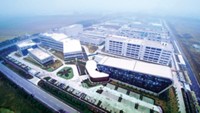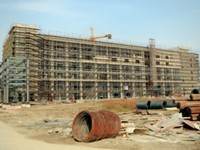Advertisement
Grab your lab coat. Let's get started
Welcome!
Welcome!
Create an account below to get 6 C&EN articles per month, receive newsletters and more - all free.
It seems this is your first time logging in online. Please enter the following information to continue.
As an ACS member you automatically get access to this site. All we need is few more details to create your reading experience.
Not you? Sign in with a different account.
Not you? Sign in with a different account.
ERROR 1
ERROR 1
ERROR 2
ERROR 2
ERROR 2
ERROR 2
ERROR 2
Password and Confirm password must match.
If you have an ACS member number, please enter it here so we can link this account to your membership. (optional)
ERROR 2
ACS values your privacy. By submitting your information, you are gaining access to C&EN and subscribing to our weekly newsletter. We use the information you provide to make your reading experience better, and we will never sell your data to third party members.
Business
An Unlikely Center For Pharmaceuticals
India has skilled labor and China has raw materials, but big drug companies prefer Singapore
by Jean-Francois Tremblay
February 27, 2006
| A version of this story appeared in
Volume 84, Issue 9
COVER STORY
An Unlikely Center For Pharmaceuticals
Over the past five years, major pharmaceutical companies have spent more than $500 million to build manufacturing facilities in Singapore. The island nation, they say, offers first-class infrastructure, a supportive government, high standards of intellectual property protection, and a motivated and well-educated workforce.
GlaxoSmithKline has been making drugs in Singapore longer than other firms. "GSK has had a long association with Singapore," says Alan Catterall, a GSK vice president and the managing director of Singapore-based Glaxo Wellcome Manufacturing. "It's been a very good experience."
Since the 1970s, the company has invested $1 billion in Singapore. Catterall himself has spent 15 of the past 20 years with GSK in Singapore, mostly at the company's main production site in the Tuas region. Beecham opened a plant there in 1973, and Glaxo started up a unit in 1982. Both firms are now part of GSK.
In recent years, many other drug companies have joined GSK in Singapore. In 2003, Pfizer and Schering-Plough both initiated production at active pharmaceutical ingredients plants in which they invested several hundred million dollars each. Lonza has begun building a $200 million biopharmaceutical plant, and Novartis is erecting a $180 million bulk drug facility.
The high level of interest in Singapore makes little sense at first glance. With its population of about 4 million, Singapore does not offer much of a market. The island is not a major supplier of pharmaceutical raw materials; nowadays, these are mostly made in China or India. Moreover, owing to the youth of Singapore's industry and its rapid growth, there is a limited supply of people with relevant experience. Again, India and China are better endowed with skilled human resources.
Another strike against Singapore is the cost of operating there. "It depends on the exchange rate used, but if you take an average for the past 10 years, the cost of operating here is marginally lower than in the U.K.," Catterall says. Other firms claim that costs in Singapore are notably lower than those in Western countries, but clearly, managers looking for the lowest operating costs would get better results in China or India.
And why are drug companies investing in new capacity at all? From Italy to India, the word from pharmaceutical contract manufacturers and industry consultants is that large drug companies consider manufacturing a noncore activity. Increasingly, the story goes, drugmakers are focusing on R&D, marketing, and distribution.
Beh Swan Gin, director of biomedical sciences at the Singapore Economic Development Board (EDB), agrees that big pharma is outsourcing more, but he says these large players still invest in their own manufacturing capacity to produce the newest products that earn the greatest profits.
For these products, constant output is of critical importance, and drug companies believe that this is best achieved by owning and operating the plants where they are made. "If you have a product that earns $5 billion annually, you don't want to take a risk by outsourcing to a contractor," Beh says.
GSK's Catterall notes proudly that at the plant built by Glaxo 22 years ago, no order has been shipped late. The unit was built originally to produce ranitidine, the key ingredient in the ulcer drug Zantac. It's now a multipurpose plant that may soon produce the active ingredient for the antiflu drug Relenza.
As for the high cost of operating plants in a first-class environment such as Singapore, Beh says it is a minor point. "Where would you save money if you went to China?" he asks. "The production equipment you'd use is the same as anywhere else. You'd save perhaps 30% on the construction of the buildings, and in a highly automated plant, you employ fewer than 200 people, so the actual labor savings is not a lot."
Catterall says Singapore has numerous attractions beyond its infrastructure. It's politically stable, with only its third prime minister in more than 40 years. Corruption, a problem in most Asian countries, is nearly nonexistent. The workforce, highly educated, speaks English as a first language, and many speak Mandarin as a second. And the generally probusiness government is particularly friendly to the pharmaceutical industry as it strives to turn Singapore into a world-class hub of biomedical manufacturing and research.
Through EDB, the government of Singapore offers an array of incentives to lure foreign drug companies to the island. But these advantages, Beh notes, are not out of line with what world-class pharmaceutical companies would get if they invested somewhere else. In Singapore, he says, the incentives essentially consist of a tax holiday of up to 10 years and training subsidies for new employees.
Unlike other places, Singapore does not provide particularly cheap land. Beh's deputy, Yeoh Keat Chuan, insists that companies must get their land at "commercial" rates. Yeoh further specifies that although foreign companies get their land from the state-owned Jurong Town Corp., JTC gets its land through a tender process where it competes with bids from private developers.
Stefan Borgas, Lonza's chief executive officer, says the incentives offered by the Singaporean government were the "icing on the cake" when the Swiss company decided to build a large mammalian cell culture plant in the city-state. Of more importance, he says, was the reputation of Singapore as a place where intellectual property is treated seriously. "In biopharma, the question of IP is much more important than it is with small molecules," he says.
Lonza already operates a major mammalian cell culture plant in Portsmouth, N.H., but decided it needed a second plant as an alternative supply source for its customers. Construction of the $200 million plant recently got under way and will be completed in 2008. The Asian market for biopharmaceuticals is mostly in Japan for now, but Borgas expects much more regional demand in the next decade.
Borgas accepted from the start that Singapore could not readily provide a labor force skilled in mammalian cell culture; after all, such skills at the plant operator level are rare anywhere in the world. For the purpose of training, Lonza has already brought a few Singaporeans to its development center in Slough, England. As the opening of the Singapore plant nears, Lonza will also send some of its newly hired Singaporean workforce to Portsmouth. Depending on its final configuration, the new unit could employ up to 400 people, he says.
Borgas won't reveal details of the assistance that EDB is providing to help cover the cost of sending Singaporeans to the U.K. and the U.S. Generally, EDB demands that companies keep confidential the details of their incentive packages. The government of Singapore, through its venture capital arm Bio*One, is a shareholder in the Lonza operation.
Largely owing to the business-friendly environment it found in Singapore, GSK has over the years moved beyond manufacturing on the island to a whole range of activities. The company's Asian operations are managed from Singapore's central business district. Twenty-seven scientists conduct preclinical R&D at a lab in Biopolis, a series of new buildings where the government hopes to create a Singaporean biomedical research cluster (see page 10). GSK plans to add to its workforce at Biopolis to conduct medicinal chemistry.
GSK's manufacturing operation is expanding as well. The firm is building a pilot plant that will develop synthetic routes to new products. And it will build a plant to produce vaccines for the global market. Catterall says Singapore is a "crucial" location for GSK, one where new pharmaceutical ingredients are made, both for clinical trials and for commercial launch.
GSK employs 650 people in Singapore, about two-thirds of them in manufacturing. As the complexity and breadth of the company's activities in Singapore have expanded, it has come to appreciate the city-state as a place where people easily move in and out. The airport is one of the world's best connected, and it's simple to obtain work visas for those coming from abroad.

Over at Pfizer's three-year-old bulk-pharmaceutical plant, Kenneth A. Bradley, the managing director responsible for the site, recalls that his company moved about 20 experienced employees into Singapore from its plants in China and India. Some came from the Chinese city of Dalian, where Pfizer has a packaging and formulation plant. Others came from Hyderabad and Chandighar in India, where Pfizer closed some facilities. Bradley says it came as a surprise that so many employees agreed to move to Singapore.
Nearly entirely automated, odorless, and spotlessly clean, the Pfizer facility shows signs that the company went all-out to build a showcase. The control room, dreary and windowless in many other plants, has the feel of a bright airport business lounge. In the production area, the floors and vessels sparkle with cleanliness. Bradley notes that the vessels, up to 20,000 L in size, are filled and emptied via a network of pipes rather than through trapdoors, and the filter dryers are filled and emptied of solids through intermediate bulk containers and change stations rather than through the hatches. This helps reduce the dust inside the plant, he says.
Back in the 1990s, Bradley says, Pfizer felt it needed to diversify the geography of its plants, which were mostly in Puerto Rico, England, and Ireland. Singapore was Pfizer's first choice, but the plan really got in motion in 2000 when the company acquired Warner-Lambert, which was in advanced stages of negotiations with Singapore.
Pfizer, GSK, and other large drug companies are investing in Singapore, but, with the exception of Lonza, contract manufacturers are not. The likes of Hovione, Ranbaxy Laboratories, or Degussa operate facilities outside their home base, but not in Singapore. Bradley believes one reason large drugmakers are the ones moving in is their ability to compensate for what Singapore lacks. Large multinationals, for instance, have sophisticated training programs that can compensate for the shortage of experienced staff in some specialized areas.
Ordinary citizens of Singapore readily gripe to foreign visitors about the high cost of obtaining medical care or sending children to school. But big companies, in contrast, appear to have found the perfect place. "Singapore is itself managed like a big corporation," Catterall says. "The government promotes a partnership between themselves, the unions, the citizens, and the companies here in Singapore, all working together for the betterment of Singapore." It's a goal the country finds it can support with the help of large drug companies.






Join the conversation
Contact the reporter
Submit a Letter to the Editor for publication
Engage with us on Twitter